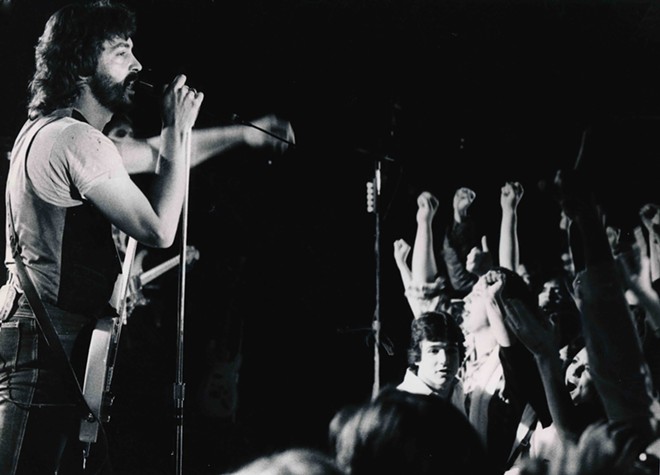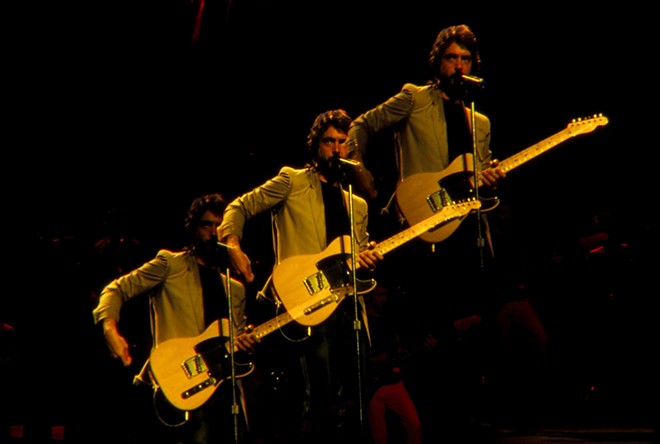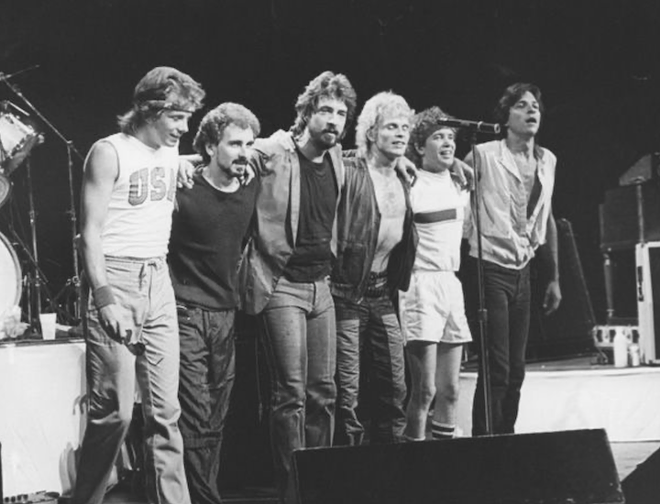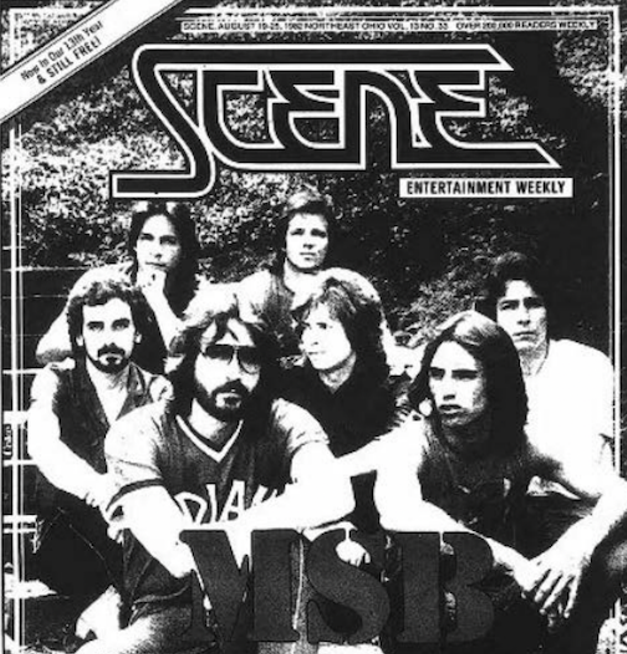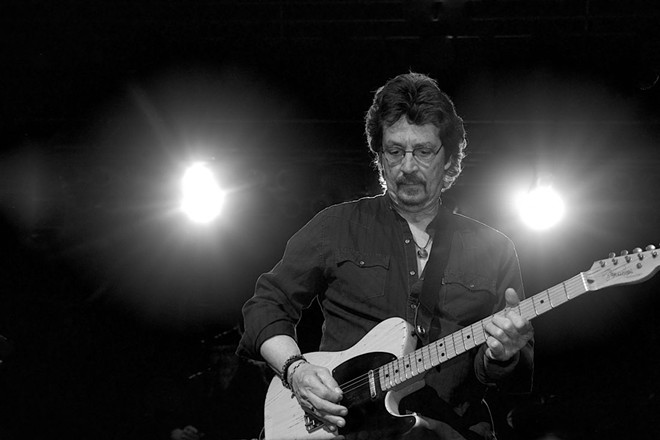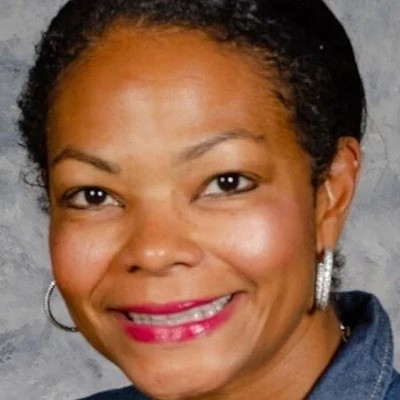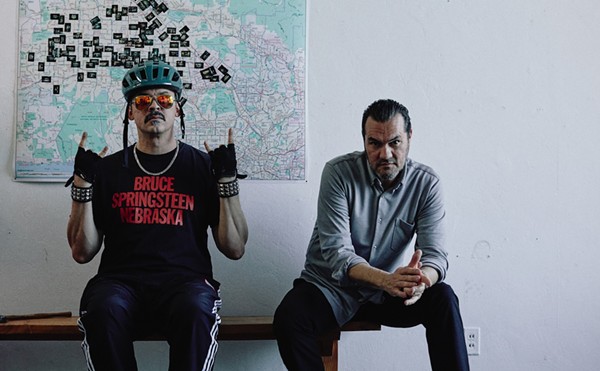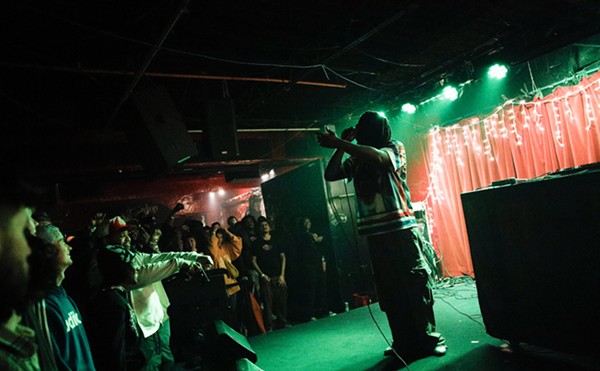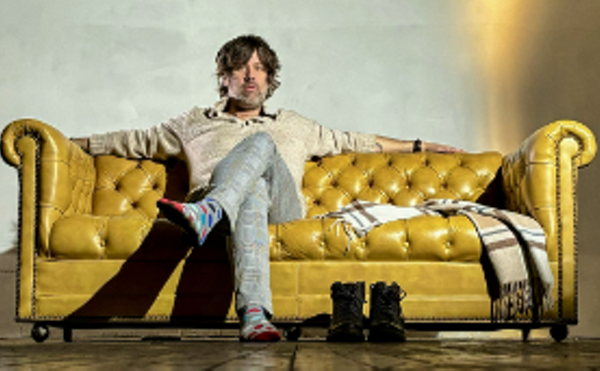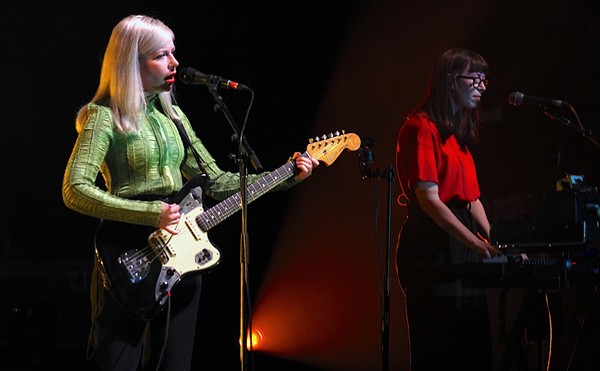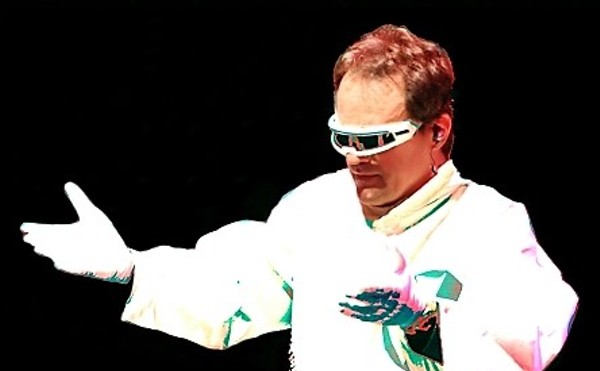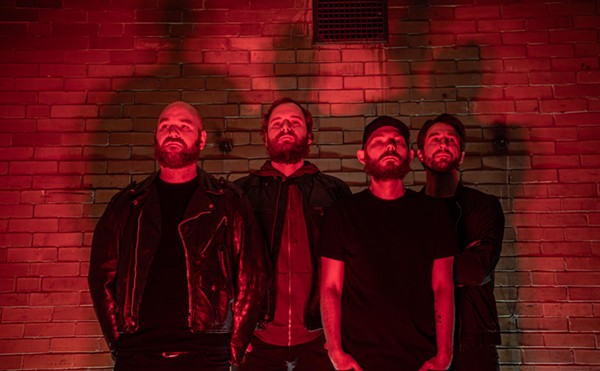Before Cleveland had Bernie Kosar, LeBron or Drew Carey, the city’s beloved hero was Michael Stanley, a Rocky River kid turned local legend, a rockstar who found stints of national fame during his decades-long career but who captured the hearts and minds of Northeast Ohio so fully that, for us, there was, for a time, no bigger star.
Part of what makes Stanley’s lore so proverbial was how he did for Cleveland what Bruce Springsteen was doing for New Jersey, but better. His songs were almost always written with the city in mind – genesized by what he knew. He was a hometown boy who never left home.
“He loved Cleveland and Cleveland loved him,” former Michael Stanley Band drummer Tommy Dobeck told Scene. “Never did we take anything for granted with our Cleveland crowd. We never played a show that didn’t last almost three hours. Michael always insisted the fans get their money’s worth, where we play every song that they know. He was very big into that, making it right.”
Fans might argue over when the Michael Stanley Band’s apex was, but, commercially, it was their run from 1980 until 1983, where they released Heartland, North Coast, MSB and You Can’t Fight Fashion consecutively.
And while that commercial success spread beyond the borders of Cleveland – “He Can’t Love You,” from Heartland, featuring Clarence Clemons, who asked only for a bottle of vodka upon his arrival at the studio in Beachwood before recording his solo, peaked at No. 33 on the Billboard Hot 100 – its epicenter was in Ohio and the heart of the Midwest.
“When I would walk into a station within 200 miles of Cleveland, it was like I was walking in with the latest Springsteen album,” Chris Maduri, the former national promotional director for Belkin-Maduri Music, told Scene. “The reception was huge, because Michael was a monster back then.”
The early 1980s were also a big time for Blossom, and 1982 in particular, when the serene, exurban amphitheater built and owned by the Cleveland Orchestra drew a then-record 635,000 fans over 150 days of events, including shows from Elton John, James Taylor, the Blue Oyster Cult and the Go-Go’s that brought in good numbers.
But more than 10 percent of those fans – some 74,404 – belonged to one act alone: The Michael Stanley Band.
The kid from Rocky River ended up at Hiram College on a baseball scholarship in the late 1960s.
While there, he performed under his birth name, Michael Gee, in a cover band called the Tree Stumps before playing bass in a local band called Silk. The soft-rock, Bread-like quartet, composed of Stanley, Randy Sabo and Courtney and Chris Johns, put out their only LP, Smooth as Raw Silk, through ABC Records in 1969. It came to life by way of Bill Szymczyk’s direction behind the boards. (Szmyczyk would eventually go on to helm the production on Stanley’s first two solo records, his self-titled debut and Friends and Legends, and then, eventually, LPs by the J. Geils Band, Eagles, Rick Derringer and, of course, the Michael Stanley Band. )
When the Michael Stanley Band arrived in 1974, it was through a partnership between Stanley and Beachwood native Jonah Koslen. They were both singer-songwriter types, getting stoked on the soft rock tunes dominating the Billboard Charts but imbuing their own takes with a Midwestern flair. The pair welcomed David Spero in as their manager and eventually teamed up with Daniel Pecchio, who was a bassist in Youngstown’s Glass Harp, to form the first iteration of the Michael Stanley Band. (In the early days of Glass Harp, the band considered Joe Walsh, a friend and collaborator of Stanley’s, as their lead guitarist, but he eventually found his footing in the James Gang.)
As soon as the trio came together, they hit the road, opening for the Eagles on their On the Border tour. When they saw another local group, Circus, play at the Agora, they saw Tommy Dobeck man the drumkit and fell in love with his playing right away. “I just had wrist surgery, so it was pretty funny [because] my left hand was in a bandage,” Dobeck said. “But [Stanley, Koslen and Pecchio] came up to me and introduced themselves. The three of them kept hanging out around the drumset. I said, ‘Well, something’s a little weird. They’re putting their ear[s] toward me.’” After the show, Stanley invited Dobeck out and the guys ended up at a nearby Denny’s talking shop. “They said to me, ‘You know, we’re putting the band together and we need a drummer and we’d like you to try it out,’” he said.
Once Dobeck was fully in the picture, the guys were tinkering with the beginnings of a real rock band, opening for pre-Neil Peart Rush and Bruce Springsteen before he went big. Cleveland’s music scene, at the time, was peaking, with bands like the James Gang, the Raspberries, Mirrors, Electric Eels and the Styrenes helming the city’s sonic alchemy. Everything from power pop to protopunk to folk rock was embedded in its DNA.
“Cleveland was just a great rock town, there were a lot of very good bands playing,” Koslen said. “It was terrific and a very exciting time. [Everyone] had a lot of support from John Gorman at WMMS and all the jocks over there. It was great for a young guy to be in a scene like that, to have all that energy around the bands.”
On the first two Michael Stanley Band albums, You Break It…You Bought It! and Ladies’ Choice, the guys were trying to replicate what the Eagles had already perfected: a southern-tinged, soft rock charm. But Stanley and company were only at the genesis of their songwriting and considered themselves to still be a garage band. “When I go back and listen [to the first two albums], I can listen to the acoustic stuff, the singer/songwriter stuff where we did a lot of harmonies, and I’ll really, really enjoy it,” Koslen said. “But some of the rock stuff we did at the time, even though it was consistent with what was going on [in popular music] at the time, it sounds really dated to me.”
In 1976, the band was putting the final mixes on Ladies’ Choice and needed a keyboard player to do the organ and piano parts live. Bob Pelander was playing in a funk band while attending Baldwin Wallace with Phil Alexander, the lead singer of Circus. “That’s how I got to hook up with [Dobeck],” Pelander said. “We were playing at an old penthouse, way up on the top floor, and I’d gotten a call from David Spero. He’d mentioned to [Dobeck] that Stanley was looking for a keyboard player.” Spero, Koslen and Dobeck showed up at one of Pelander’s gigs, liked what they heard and invited him to Stanley’s house in Chagrin Falls for an audition. He brought his entire rig – a five-keyboard stack – and went through the band’s setlist. “I guess I passed the test,” Pelander said. “I was invited to sing background vocals on Ladies’ Choice. I sang on ‘Strike Up the Band,’ but didn't play a damn note.”
Koslen cites the band’s breakthrough coinciding with Pelander’s addition and 1977 would become a defining year for the quintet, as they recorded their third album, Stagepass, live at the Agora Ballroom and had marquee acts such as Billy Joel open for them at the Allen Theatre. Stagepass went gold, produced a Top 100 hit in Koslen’s “Nothing’s Gonna Change My Mind,” and signaled a swell in the band’s momentum.
“We were a true rock band by then,” Koslen said. “What you hear [us] playing on Stagepass, you could draw parallels between our jams and the Allman Brothers Band’s jams. We had all these flavors of what was going on in the ‘70s and it all translated into our sound. We’d come into our own.”
Though that momentum would carry on until the band’s eventual dissolution in 1987, Koslen would be gone by the end of 1977 and Spero was traded in for Mike Belkin Sr., a local concert promoter who managed the James Gang, Wild Cherry and Donnie Iris & the Cruisers, and who created the World Series of Rock at Municipal Stadium.
With Koslen off making his own music, keyboardist Kevin Raleigh and guitarist Gary Markasky stepped in to help make Cabin Fever in 1978.
Stanley and company continued touring rigorously, playing shows at legacy venues across the country, like the Roxy Theatre in Los Angeles and The Palladium in New York, opening up for Styx, Journey, REO Speedwagon and Foreigner. But it was in Northeast Ohio where the most noise was made.
“There were pockets [of fans] here and there,” Dobeck said. “But then we’d come back home and find ourselves headlining.” Though the records were charting and, regionally, the group’s following was surging, the Michael Stanley Band was far from a household name outside of the Midwest. “In Cleveland, they knew every song. We could play anything,” Dobeck said. “But one time we played in front of a big crowd at the [Richfield] Colosseum and then, the next night in Chicago, we played a club concert for about 25 people.”
The band rarely flew to shows, opting to drive state to state. According to Pelander, they were always leveling up to the next, most-accessible, form of wheels, progressing from station wagons to motorhomes and the occasional limousine. Pelander and Stanley found themselves at the forefront of a very noticeable gust of local stardom, which arrived, in part, due to Stanley’s growing legend on-stage.
“Michael was very charismatic and I think he had always been that way,” Pelander said. “He learned to become a frontman. I don’t think he always wanted to be that guy, but he picked it up pretty quick.”
It’s part of what had hometowners making the trek to shows around the country.
As the band traveled far and wide to places like St. Louis, Milwaukee and Long Beach, the fans followed. It was Northeast Ohio’s own rendition of Dead Heads.
“We did one tour where we were just doing club shows throughout the country,” Dobeck said. “And, every night, I remember Michael commenting, ‘Is anybody left in Cleveland?’”
Stanley’s stardom in Northeast Ohio became fully realized when he linked up with Mike Belkin Sr. in the mid-1970s, the beginning of a relationship that lasted more than 40 years, spanning across multiple record label changes, the Michael Stanley Band’s ending, Stanley’s time at WNCX and his eventual resurgence with the Resonators.
“They never had a hiccup,” Belkin’s son, Mike Jr., said. “You know, careers go up and careers go down, but their relationship never wavered. It was probably one of the two or three most important things in [my dad’s] entire professional career.”
Mike Sr. and his brother Jules aimed to make Stanley the biggest musical act in Cleveland and succeeded with flying colors. According to Maduri, they wanted to go out and break attendance records at venues across the city.
On December 31st, 1981 and January 1st, 1982, the band did just that, drawing a record two-night audience of 40,529 people at the Richfield Coliseum.
Afterwards, they pivoted their focus to August 1982, when MSB was slated for release.
Blossom Music Center, the pavilion in Cuyahoga Falls owned by the Musical Arts Association, handled the bevy of local summer shows because it was Cleveland’s premiere outdoor venue. Though the booking agents at Blossom had excellent relationships with the management of the major touring artists, the venue actively competed commercially with Belkin Productions, because the pavilion only had five months of good weather to present live music, as opposed to Belkin’s year-round promotional capacity. Most of those summer Blossom dates were occupied by the Cleveland Orchestra, too, so availability sometimes ran thin. But for Michael Stanley, the two sides worked together.
When the Belkins met with representatives from Blossom, they laid their agenda out firmly: book as many days as possible, because it meant so much to Stanley to do all of his shows there. The more dates added, the more visibility it would bring to the band altogether.
“That decision was made with the expectation that Blossom would do very well,” Chris Abood, Blossom’s PR Director in 1982, said. “Michael had sold out, or been close to capacity, the other shows he had done there, and there was also new music the band had been making. While I think it might have been considered a risk, it was certainly something that [Blossom] and Belkin Productions both agreed, ‘Yeah, let’s knock this thing out of the park.’”
They scheduled the band for four nights – August 25th, 26th, 30th and 31st – and got to pumping the promos, which wasn’t a hard sell in Cleveland.
At the time, the group was no longer the quintet that rocked the Agora over and over, but a seven-piece machine filling out arenas, with a lineup that featured Stanley, Dobeck, Pelander, Markasky, Raleigh, Michael Gismondi and Rick Bell. The year prior, North Coast found good chart success, peaking at 79 on the Billboard Top 200, setting the band up well for another year of touring. 1982 would be not just the most important year in the mythology of the Michael Stanley Band, but it would be an untoppable chapter in the hearts of many fans.
As the stretch arrived, the weather forecast looked great and the buzz from early ticket sale numbers warned of a packed house for the first two performances. (Those who attended remembered gnarly traffic, even for Blossom, and recalled cars stranded all over the rolling terrain with people chilling with strangers, because no one could move.)
Prior to 1982, the band would drive to the venue themselves whenever they had a gig there. But to kick off the record-setting run, management wanted to send the guys to Blossom in style and had them all show up in limousines. Everyone who was close with the guys in the band and wanted a guest pass got one. The backstage area was filled every night with friends, employees and family, including Stanley’s dad, who Abood affectionately refers to as “Mr. Gee,” his wife Libby and his twin daughters, Anna Sary and Sarah Sharp.
When Scene interviewed Stanley a week before the shows for a cover story in advance of the four-night stretch, he tucked his daughters into bed before sitting down with Marc Holan to talk about MSB. The frontman was a part-time superstar and full-time dad, and, sometimes, those parts of him overlapped. While Stanley warmed up with the band before each set, his daughters were always nearby, playing by the stage and taking advantage of the energetic, summertime excitement that washed over the venue.
“We were in elementary school when our dad was at the height of his career,” Sarah said. “We were too young to really appreciate what a big deal the record-breaking shows were at Blossom, but we have so many wonderful memories of running around the pavilion during soundcheck and hearing the roar of the crowd each night as the band made their way onto the stage. It was magical.”
In his interview with Stanley, Scene writer Marc Holan broached the topic of the frontman’s success in Cleveland by posing the question: “Does anything surprise you anymore?” Stanley responded humbly, saying that he never took anything for granted and expected no one to like the band’s albums. “I’m surprised that we’re doing four nights at Blossom,” he said. “I’ll be surprised if all four of them sell out. I’ll be surprised if three of them sell out. I’m surprised at all this stuff. It’s still very surprising to me.”
Not knowing that a record-breaking week was on the horizon, Stanley’s words now ring loudly, as both an affectionate document of a regional phenom’s humility and a gratitude for his hometown fans that never withered. Even during shows, as the band ripped through the classics of their catalog, Stanley never leaned into his own stardom.
“My father asked me what it’s like being up there onstage in front of 22,000 people, and I say, ‘At the time, I really don’t know…’ You don’t have the time to stop and think about it.”
When the band would come out for those Blossom nights, it was all hands on deck, minus Stanley. The frontman had his own special moment, where he’d grace the stage under a spotlight.
“It was deafening. He was really a rock star then,” Maduri said. “I remember I was standing down in the pavilion area. It was emotional for all of us who were working for him, to have that kind of success, when that first song started.”
Maduri remembers one touching moment from a ride home during the run.
“Somehow, someway, I ended up in the limo with Michael, my brother Carl and Mike Belkin Sr. The four of us were racing up I-271, back to the Chagrin area. I have no idea how that happened. There was a car on the side of the freeway next to us, beeping, hitting their horn. The guy put his window down and mine was cracked. He was screaming, ‘Michael! Michael! Can I get your autograph?’ We’re clipping along at 70 miles per hour on I-271 North and Michael wanted to do it! So the limo driver just kept pace with that car. I remember it was on my side, we put the window down. It was very dangerous and almost stupid, but Michael was trying to do it.
“The window went down and he was reaching to try and get the paper from the guy. The limo driver was just trying to keep parallel with the guy and it didn’t work out, because we were going so fast. The guy in the car mistook it as Michael was ignoring it, so he started to yell a lot of profanity at Michael. It was this weird little cool moment that turned dark. Michael just dropped back in the seat, we put the windows up and he got really upset because he cared about every fan. He really got upset that he couldn’t give that guy an autograph and that he’d probably never come to another show. He just felt really, really bad. And then everything got quiet in the limo for the rest of the trip up to Chagrin Boulevard. It was something only four of us witnessed and it said a lot about the attitude he had towards interacting with his fans.”
That connection endured even through critiques by his longtime supporters. In its Aug. 26 - Sept. 1, 1982 issue, Scene ran a letter from Stacey Sharp, a local fan who felt “betrayed” by the band after the publication’s “MSB Opening Act” contest (co-hosted by WMMS) promised Eddie Money would strike up his band before Stanley’s at the August 25 show, which didn’t happen. “I am sure that Wednesday night will nevertheless, be a good time and a good show,” Sharp wrote. “But as I sit here listening to Eddie Money I can’t help but feel deceived, as well as $10 poorer.”
(In the same issue, Money was interviewed by Scene’s Keith Rathbun and proclaimed: “(Michael Stanley’s) a nice cat and he’s got a real great band. But when I come through Cleveland I’m going to do the ‘Eddie Money Show.’ I want to headline there.”)
The following week, Stanley empathetically responded to Sharp with a letter of his own, providing a backstory to Money’s cancellation with the hope of making things right. “It was Eddie’s choice to turn down the dates, and I am truly sorry Stacey that you feel ‘betrayed’ and ‘taken,’” he wrote. “I hope this letter clears up some of your assumptions. We try to make each MSB show one that you will remember. I hope this year’s Blossom shows made up for Mr. Money’s absence.”
Dobeck said that after one of the shows, his ride left him at Blossom and he didn’t have a way back to downtown, before jokingly suggesting that, if it had been up to Belkin Productions, there would have been six shows in total. And though Pelander called it a “nightmare,” the drummer joyously recounted the night a rainstorm nearly flooded the lawn area. “They had a mudslide on the side of Blossom,” Dobeck said. “I was sitting up [on my riser] watching the kids slide down this hill and a cop tried to grab the kid at the top of the hill. The cop didn’t want the kids to ruin the grass, but he ended up going down the hill with them.” Dobeck’s favorite memory, however, came later that night, by way of Stanley falling on his ass when he ran across the stage. “It was the funniest thing I ever saw,” he said “Michael was far more animated in those days, and he slipped and, literally, did this roll [across stage]. He got up right after. We were all surprised he could even stand after that. We thought he broke something. We kept playing and were like, ‘Oh my God, he’s still alive. Is he going to do that tomorrow night, too?’”
The shows endured even after the stage lights went out in Cuyahoga Falls, as the Plain Dealer and Scene reported extensively on the milestone.
In the August 27 edition of The Plain Dealer, longtime rock critic Jane Scott likened the excitement of the band’s August 25 performance to when the Beatles played Public Hall in September 1964. Scott noted that the sea of 19,000 fans was almost four times the size of Stanley’s hometown of Chagrin Falls and that the crowd’s screams began around 8:45 p.m., when the band walked out on-stage. She praised the first chapter of the Blossom run, highlighting the mammoth, 29-song setlist and how wonderfully the Michael Stanley Band had evolved as a group. Scott even gave a nod to the uptick in production value.
“This concert also had the band’s first use of lasers, done sparingly and tastefully,” she wrote. “The shows continue tonight, Monday and Tuesday. I can’t think of a better way to spend those nights.”
On Facebook, a number of Michael Stanley Band groups and fanbases share memories from throughout the years. Koslen and Gismondi are no strangers to those pages, as they often join in on the reminiscing. Though the local support remains strong, which is emphasized through tribute shows selling out the MGM at Northfield Park, a question still lingers 40 years after the fact: How did the Michael Stanley Band manage to pack over 70,000 people onto Blossom’s grounds in one week?
Koslen said it’s a mix of Stanley’s artistry and the Belkins’ firepower in the industry.
“Mike Belkin, in particular, he was the real force in Cleveland,” he said. “They had a lot of clout and they put their muscle behind Michael. When I left the band, Michael had that momentum. He was a terrific musician and songwriter. He was. When he stopped working with David Spero and went on to work with the Belkins, that was what he needed to push him over, at least locally. And it worked really, really well and really fast.” The Belkins were the missing piece for Stanley and they built off of the essential foundation Spero had started. Their influence in the music business got the band on stages all around the country, but it was the band’s chemistry that sold the tickets. “It wasn’t that hard to get people in there to see Michael and to see the band, because it was really good,” Koslen said. “It was a really good band all around.”
Mike Belkin Jr. noted that Cleveland was the peak marketplace for Stanley’s career. “To this day, nobody’s done four shows [in a row] there,” he said. “The fact that he was able to play here until he passed away shows the loyalty of those fans and the quality of his material.”
The Belkins believed in the Blossom shows and knew it could change the history of rock and roll in the city. “I used to sit in that room while the Belkins and Blossom were negotiating,” Abood said. “I was a newbie there, but Mike Belkin looked at me and said, ‘You better advertise the hell out of this show. I want to sell every single seat,’ and, thankfully, we did.”
Afterward, each band member got a glass trophy commemorating the feat, but it took awhile for the impact of the shows to really sink in.
“We went about our business and started working on the next batch of songs,” Pelander said. “It didn’t sink in until years and years later. It was like a dream. Obviously the people on the business end had an idea of past ticket sales and all the metrics, but I don’t think we ever expected to do 74,000 people.”
The band had approached the shows like they would any and brought with them the same mantra: give the people their money’s worth and ride the excitement until the wheel’s fall off.
“It’s something that, when you’re in the moment, you don’t realize how special it is,” Pelander said, echoing what Stanley said before the shows. “Even something that special.”
“The lyrics were so Cleveland,” Dobeck said. “If you were from Cleveland, you got it real quick.”
It remains a perfect epilogue to the Blossom shows, when a city showed out en masse for their favorite son. Though the band was getting radio play in every major market, 50% of their records were sold within 100 miles of Cleveland.
“He was happy to be here and [Cleveland] was happy to have him. I think that’ll last a long time,” Dobeck said. “It was his charisma on-stage and his songwriting. He was able to write a lyric that people could identify with a part of their life or a story they were going through. I hate to say it was all him, but it was all him. I was lucky to be on the ride.”
On May 29th, 2022, at the Robins Theatre in Warren, Ohio, a few-hundred longtime fans of Stanley packed into the seats to watch the Resonators and Koslen pay tribute to their late friend, one of a slate of tribute concerts organized after Stanley’s death. Parents, who used to have Michael Stanley Band records in their tape decks in high school, brought their kids along, passing the musical communion down to them. The songs still endure and you could see so brightly that Stanley is as deeply missed as he is eternally loved. But no matter how loud the music plays, there’s still a hole in the stage where he used to stand.
“There’s nobody that can take Michael’s place. He was with the people in Cleveland every single day,” Koslen said. “The audience still wants to come out and be around the experience again, even after Michael’s gone. He’s created this community of people that gather around him. Yes, they gathered for the music, but they also gathered in a very personal way. They felt this connection between each other, too, and with Michael. And that still remains today.”

